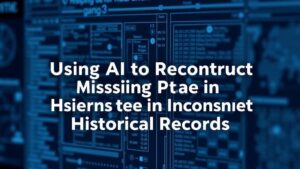Prompting AI to Simulate Historical Migration Patterns for Fossil Discoveries
Prompting AI to Simulate Historical Migration Patterns for Fossil Discoveries
The intersection of artificial intelligence (AI) and paleobiology poses a unique opportunity to enhance our understanding of historical migration patterns and their implications for fossil discoveries. By leveraging AI techniques to simulate various migration scenarios, researchers can generate predictive models that facilitate targeted fossil hunting and contribute to the broader discourse on species evolution and environmental adaptation.
The Necessity of Using AI in Paleobiology
The study of fossils is inherently tied to understanding historical ecosystems and the movements of species. Traditional methods involve extensive fieldwork and analysis of geological layers. But, these methods often lack the efficiency and scale required to delve into the complexities of historical migration patterns. AI technology can process vast amounts of data–from genetic studies to climatic models–thus enabling researchers to simulate scenarios that would be nearly impossible using manual methods.
Historical Context of Migration Patterns
Throughout history, species have migrated due to various factors, including climate change, availability of resources, and geological events. For example, during the Pleistocene Epoch (approximately 2.6 million to 11,700 years ago), Eurasian megafauna, such as mammoths and saber-tooth cats, migrated across a land bridge that connected Asia and North America. Understanding these migration routes is crucial for locating fossils that provide evidence of these organisms existence.
AI Techniques for Simulating Migration
AI utilizes several methodologies for modeling migration patterns. Some of the most relevant techniques include:
- Machine Learning: Algorithms trained on historical data can predict where species may have migrated based on climatic and geological changes.
- Geographic Information Systems (GIS): AI can integrate spatial data with environmental variables to visualize migration paths.
- Neural Networks: These can model complex relationships between variables to forecast how species distribution might have shifted over time.
For example, a study published in the journal Nature Communications utilized machine learning to analyze the migrations of the woolly mammoth across the Bering Land Bridge. The researchers were able to identify potential fossil sites based on predicted migratory routes, resulting in a targeted excavation that uncovered significant finds.
Applications in Fossil Discoveries
Simulating historical migration patterns can significantly guide fossil excavations. By identifying geographic regions most likely to contain fossils of particular species, researchers can focus their efforts more efficiently. For example, in studies conducted in North America, simulations have indicated that certain riverbanks along the Mississippi River were hotspots for fossil discoveries due to migratory patterns of prehistoric animals.
Challenges and Limitations
While using AI to simulate migration offers numerous advantages, there are inherent challenges. One major limitation is the availability and quality of data. For example, incomplete fossil records or gaps in geological data may result in inaccurate simulations. Also, the complex nature of ecosystems and numerous influencing factors means that simulations can only provide probabilities rather than certainties. Researchers must be cautious in interpreting the results and ensure that simulations are validated with empirical data.
Future Directions and Research Opportunities
As advancements in AI technology continue, the potential for more sophisticated simulations grows. Future research may focus on enhancing data integration methods, improving model accuracy, and exploring the use of AI-driven robots for excavation. Also, interdisciplinary collaboration between paleontologists, climatologists, and data scientists will be essential to refine models and interpretations.
Conclusion
The alignment of AI technologies with the goals of paleobiology offers a transformative avenue for simulating historical migration patterns and enhancing fossil discovery initiatives. By focusing research efforts on areas predicted to yield significant findings, scientists can deepen their understanding of species evolution and ecosystem dynamics. Continuous refinement of AI models, coupled with a robust data collection strategy, will propel this field into new realms of discovery.
Actionable Takeaways
- Encourage interdisciplinary collaboration to enhance data quality and model accuracy.
- Invest in training programs for researchers on the application of AI technologies in paleobiology.
- Establish comprehensive data repositories that incorporate geological and fossil records for better model training.
By addressing these action points, the research community can maximize the benefits of AI in the exploration of fossil discoveries, ultimately enriching our understanding of historical migration patterns and species evolution.
